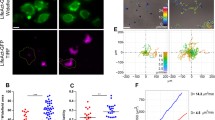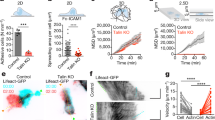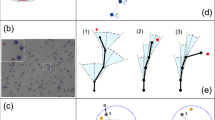Abstract
Locomotion is a characteristic of many cell types, including malignant cells. It is driven by a combination of interacting factors, one of which is recognized to be the surface microtopography. In this study, an in vitro analysis of cell migration was carried out to observe and quantify the differences in locomotion of two types of lymphoid cell on both flat and grooved surfaces. The cells studied were peripheral blood T lymphocytes (PBTL) and a malignant T lymphoma cell line (HUT78). It was found that, on the grooved pattern, the lymphoma HUT78 cells were more diffusive in their migration than the T lymphocyte PBTL cells whereas, on the flat surface, the T lymphocyte PBTL cells had a more diffusive response than the T lymphoma HUT78 cells. It was also found that malignant T lymphoma cells are significantly slower and less diffusive when exposed to a plane substrate than when subjected to a grooved substrate. On the contrary, PBTL cells showed only a moderate drop in cell speed and diffusion on the grooved compared to the flat substrate. PBTL cells did, however, show a general alignment to the direction of the grooves whereas HUT78 did not. Therefore, we have found that the surface topography can influence the motile response of the two different T cell types in different ways, and this can be quantified in terms of motility parameters. This difference may have exploitable applications for cell sorting. © 2003 Biomedical Engineering Society.
PAC2003: 8717Jj, 8715Vv
Similar content being viewed by others
References
Curtis, A., and C. Wilkinson. Topographical control of cells. Biomaterials18:1573–1583, 1997.
Dunn, G. A. Characterising a kinesis response: Time averaged measures of cell speed and directional persistence. Agents Actions Suppl.12:14–33, 1983.
Gail, M. H., and C. W. Boone. The locomotion of mouse fibroblasts in tissue culture. Biophys. J.10:980–993, 1970.
Gail, M. H., and C. W. Boone. Cell-substrate adhesivity: A determinant for cell motility. Exp. Cell Res.70:73–40, 1972.
Lackie, J. M. Cell Movement and Cell Behavior. London: Allen & Unwin, 1986.
Lo, C.-M., H.-B. Wang, M. Dembo, and Y.-L. Wang. Cell movement is guided by the rigidity of the substrate. Biophys. J.79:144–152, 2000.
Meyle, J., K. Gultig, and W. Nisch. Variation in contact guidance by human cells on a microstructured surface. J. Biomed. Mater. Res.29:81–88, 1995.
Muller, W. A. Leukocyte-endothelial cell interactions in the inflammatory response. Lab. Invest.82:521–533, 2002.
Prina Mello, A., P. J. Prendergast, M. Moretti, and Y. Volkov. Mechanical constraint of lymphatic cells: Experimental analysis and model. MS BIO 4, 2001.
Prina Mello, A., M. A. Bari, and P. J. Prendergast. A comparison of excimer laser etching and dry etching process for surface fabrication of biomaterials. J. Mater. Process. Technol.124:284–292, 2002.
Shields, J. M., and W. S. Haston. Behavior of neutrophil leukocytes in uniform concentration of chemotactic factors: Contraction waves, cell polarity and persistence. J. Cell. Sci.74:75–93, 1985.
Stephenson, E. M., and N. G. Stephenson. Invasive locomotory behavior between malignant human melanoma and normal fibroblasts filmed. J. Cell. Sci.32:389–418, 1970.
Trinkaus, J. P. Cells into Organs. Englewood Cliffs, NJ: Prentice-Hall, 1984.
Volkov, Y., A. Long, and D. Kelleher. Inside the crawling T cell: Leukocyte function associated-1 cross-linking is associated with microtubule-directed translocation of protein kinase isoenzymes β(I) and δ. J. Immunol.161:6487–6495, 1998.
Wilkinson, P. C., J. Shields, and W. S. Haston. Contact guidance of human neutrophil leukocytes. Exp. Cell Res.140:55–62, 1982.
Wilkinson, P. C.Assays of leukocyte locomotion and chemotaxis. J. Immunol. Methods216:139–153, 1998.
Author information
Authors and Affiliations
Rights and permissions
About this article
Cite this article
Prina_Mello, A., Volkov, Y., Kelleher, D. et al. Comparative Locomotory Behavior of T Lymphocytes versus T Lymphoma Cells on Flat and Grooved Surfaces. Annals of Biomedical Engineering 31, 1106–1113 (2003). https://doi.org/10.1114/1.1603261
Issue Date:
DOI: https://doi.org/10.1114/1.1603261




